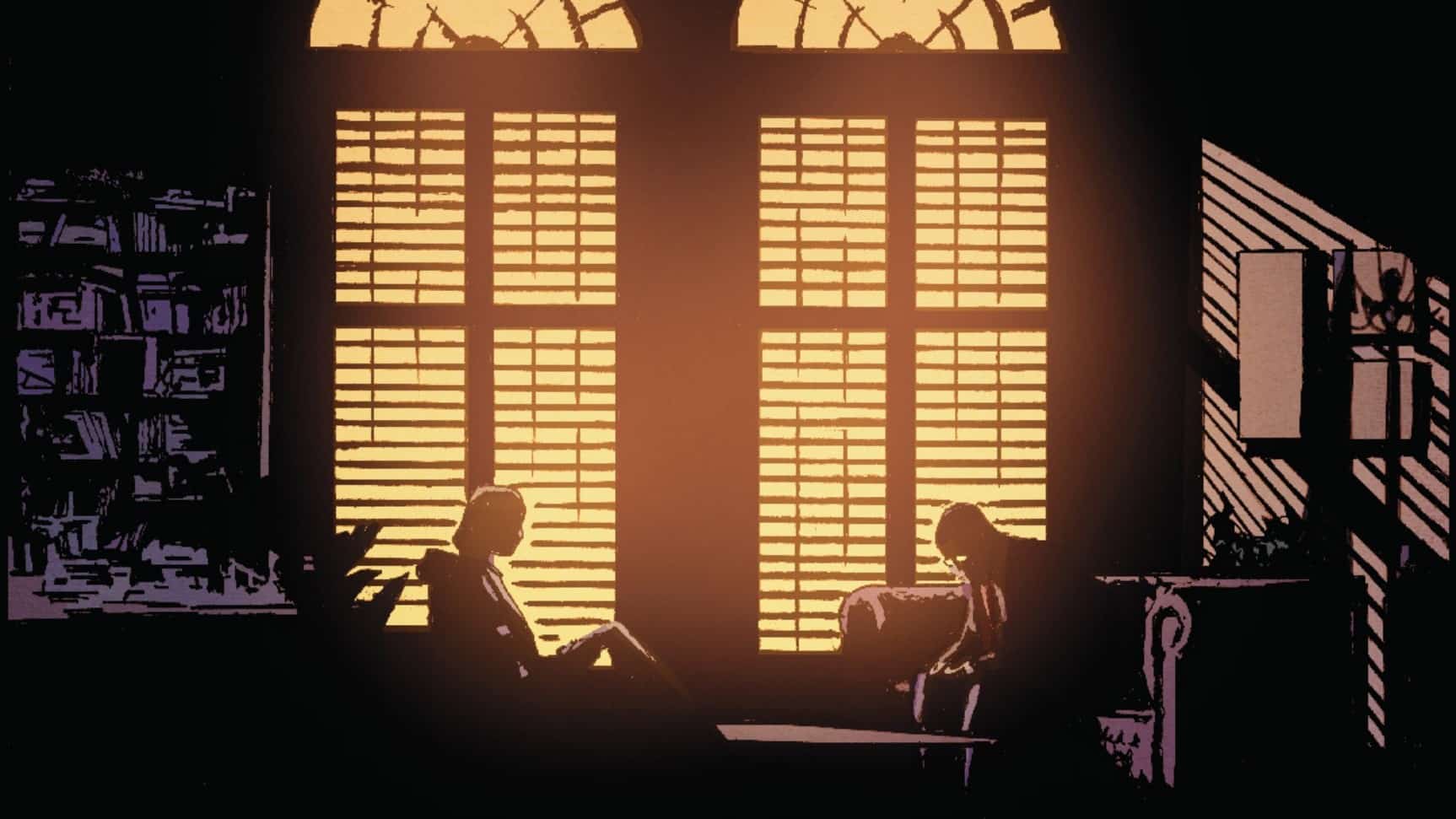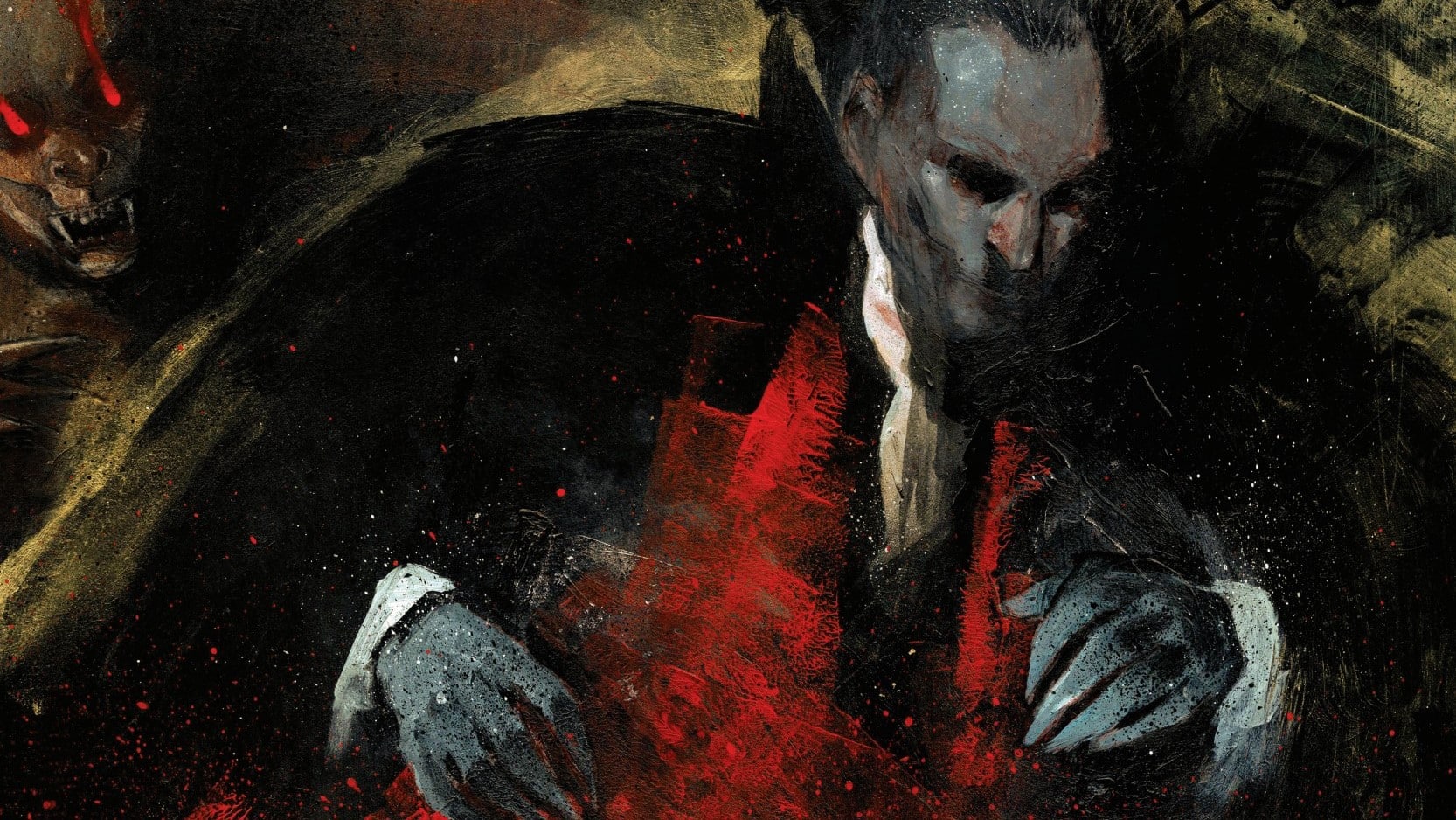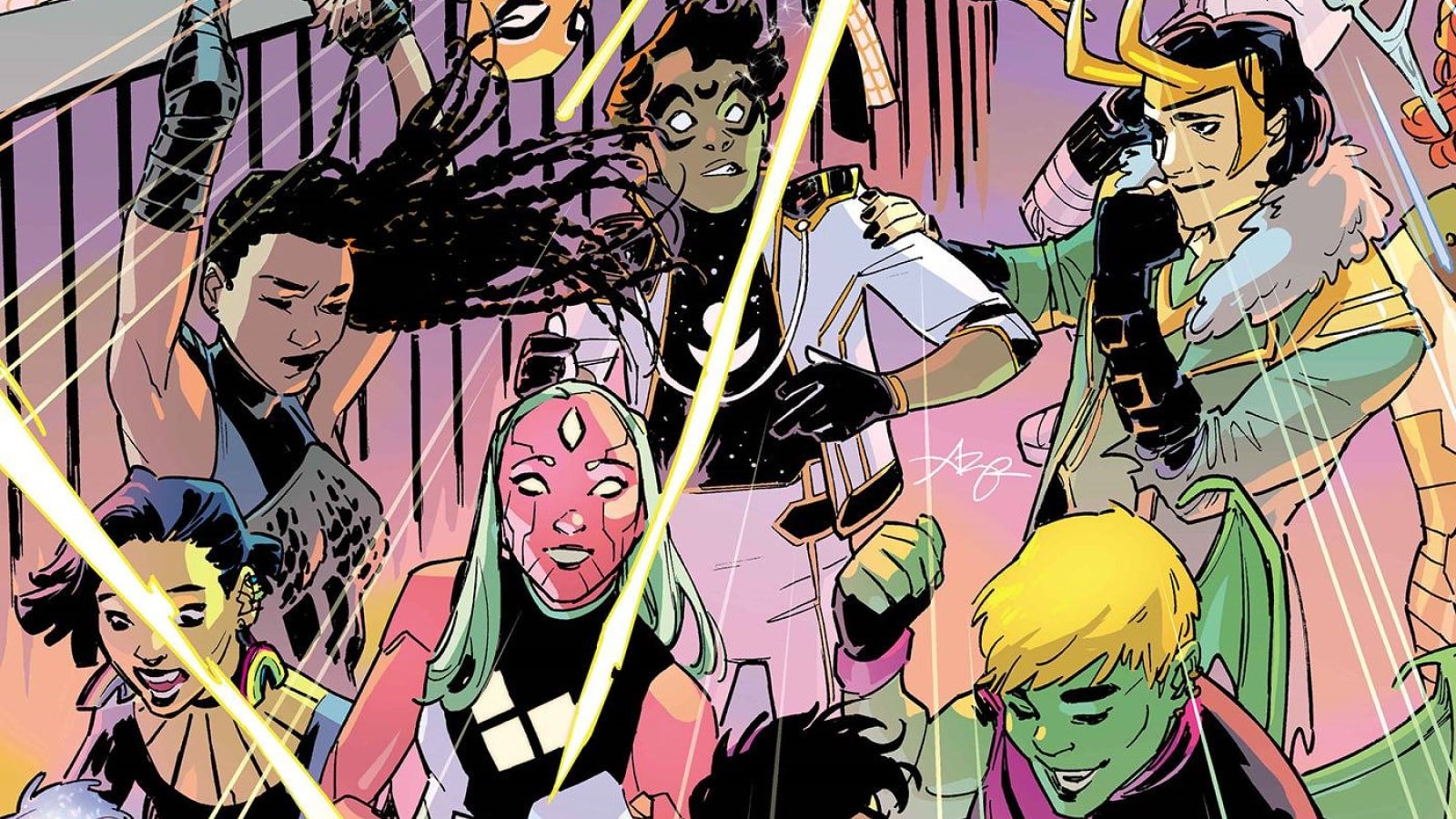The Old James House has lost its ghosts. With her new powers, it’s up to Ami to bring them back, whether they want to come home or not. Even when they’re really big ghosts wrapped in metal, with lots of sharp edges and things. Let’s unpack Image Comics’ Home Sick Pilots #2 by Dan Watters, Caspar Wijngaard, Aditya Bidikar and Tom Muller.
Dan Grote: And we’re back! We had such a good time writing about this series about a teenage punk band and the haunted house that turns one of them into its avatar, we decided to do it again. This time around we get more of an idea of what the house wants with Ami, what Ami can do with her haunted-house powers and the dark forces she’ll have to contend with going forward. And she fights a horseshoe! What did you think of this sophomore effort, Forrest?
Forrest Hollingsworth: While the introductory issues brushed with darkness, there’s an exquisitely tailored reveal of a much broader, esoteric and enveloping kind of evil here that lends itself exquisitely well to the idea of the halcyon days of our teenage summers ending. Dan, I am completely and totally in love with this comic.
DG: Same-zos. Let’s dive into it.
(Content warning for suicide)
‘They Are Old People, and They Suck’
DG: The issue opens with a flashback to the first time Ami, Buzz and Rip met, before there were Home Sick Pilots. We get an early taste of the group dynamic, and a surprisingly cogent critical evaluation of the Ramones from a character who’s supposed to be 14. More importantly, though, we get a little bit of a better look at Buzz than we did in the first issue. He appears to be the more intelligent and mild-mannered of the three, as much as you can say that about a band of teenage punks. Given he’s on the cover of the third issue, this exchange feels Important for later.
FH: First of all, Buzz is absolutely right about the Ramones, and specifically about Johnny Ramone, one of the few inexplicably proud conservative “punks” of the era who should’ve gone the way of Nazi punks (Read: f-cking off).
Secondly, I really love the relatively low stakes of the conversation the Pilots are having, and especially the way the art is evocative of the tone, just a handful of friends talking about music as the blue-pink hazy sun sets — the waning of their halcyon days. It’s the kind of setting and depiction that make Ami’s difficult decision later more important, and also a pitch perfect look at the kinds of days and nights that make people friends for life.DG: It feels like we’re nipping around the edges of the band getting back together — PUNS FOREVER! — but first, Ami’s going to have to get over her reservations about putting other people in harm’s way. She’s clearly aware of her mental health struggles and using her relationship with the house as an opportunity to work through them, which is nice to see. What do you think, Forrest, should Ami recruit Buzz and Rip for the house’s pyramid scheme?
FH: It’s tough to say at this stage! Obviously, Ami has just experienced a seriously traumatizing event, and we’re led to believe it’s not the first of her life. The stakes have dramatically increased and shifted in scope, and there’s a dignity in admitting you need help — I commend Ami for understanding that. That being said, there’s a not-insignificant amount of suggestion that the house has an influence on Ami, and its fixations and motivations are more dubious, as well as potentially nefarious.
The mixing of the two, and in a way the mixing of childhood and adult problems and responsibilities similar to the balance of the sun setting in the early pages and the immediate shift to a darker, heavy red and black and blue, is intentional. How the house and Ami will strike a balance, and how it will impact the band’s relationship in the future, is a fascinating narrative thrust.
A Game of Horseshoes!
DG: What edition of Final Fantasy is this boss from, Forrest? Feels like somewhere in the XIIIs to me. It’s got big Fal’Cie energy. I never played Lightning Returns all the way through, so I’m gonna go with that one.
FH: Well, Dan, I think the high futurism angelic-cocoon figure the house’s horseshoe takes the form of is really weirdly wonderful and unexpected in a way that’s somewhere between XIII and Warframe, which, fittingly, both call these kinds of figures ‘Eidolons’ (pushes up glasses). In any event, the mixing of existential imagery and the immediateness of monsterdom is a great way to express the inherent Sentai structure of the book, in an Ultraman-getting-crucified kind of way.
DG: Aaaaaaanyway, this issue sheds light on what Ami can do now that she is for better or worse part of the haunted house. Basically, it’s her job to go around collecting the house’s lost ghosts, which inhabit items taken from it over the years. Her first job is retrieving a horseshoe currently in the possession of a former actress. She seems more than happy to be rid of it, but the horseshoe is … less accommodating. Forrest, what did you make of the book’s first villain, so to speak? It was a pretty quick fight, yeah?
FH: Initially I was a little frustrated by the pacing of the fight, and the kind of visual confusion that comes with ‘Is the house doing this or is Ami?’ — but on reflection, I think that’s kind of the point. Neither Ami nor the horseshoe holder is really in control of the action, just avatars for bigger forces, and that’s a kind of intensely interesting and difficult concept to parse or express, so I’ll give it a pass especially because the narrative beats are really sound and compelling.
DG: In all, the issue gives us a haunting, very Dan Watters take on the concept of good luck, and how too much of it can be a curse. The unnamed ex-actress can’t die. She misses the rain. Her love life is an endless parade of himbos. It’s made her numb, to the point where, when she’s finally free of the horseshoe’s gift (and here’s where that content warning from above comes into play), she decides to end it all. It’s especially striking against Wijngaard’s heavy use of neon pinks and electric blues. What did you think about that scene?
FH: It’s a moving, intense scene that mirrors a lot of my personal mental health struggles in an evocative and effusive way both for better and worse — I’ve been there. It’s also indicative of the kind of push and pull between human interpersonal issues and larger, esoteric and existential ones the house and its adornments are interested in. Immense power comes with all of the coolness of floating up to ritzy balconies to retrieve your stolen goods, but also with forgetting the feeling of rain, the breeze of a summer night and watching your loved ones fall around you. Heavy, but overall important to establishing coherent stakes for the book’s loftier moments.
We Need to Talk about the Backpack
DG: OK, so as this duo’s Senior ‘90s Correspondent, I need to call out the backpack Ami is seen with in flashback. Growing up, if you had one of those canvas Jansports, you were practically required to deface it by writing band names all over it in whiteout. And Ami is blazin’ all the hits: Rancid, the Nine Inch Nails logo with the backward N, Pharcyde, the anarchy symbol. All that’s missing is The Cool S. And is that an X-Men pin I spy in the top right corner? You’ve got to admire that level of detail and craftsmanship. Forrest, make me feel old. Do the kids still do that? Are they still defacing their backpacks?
FH: I was born in ’93 …
DG: Again, goddammit.
FH: … and I’m still pretty fond of a lot of the things here (NIN is my favorite band), so my personal taste might not be the best counterbalance. That being said, I do work at a university, and I can categorically say that no, kids do not do this anymore. There’s been a general shift toward minimalism and color-blocking in recent eras that I think misses some of the fun self-expressive elements of bags like this. There’s still a lot of stock in the sticker and enamel-pin making market these days, but I guess everyone is keeping those at home? It’s a bummer, especially when you see how effectively it expresses who someone is on the page like this … aaaaaaand now I’m eyeing backpacks on Amazon. We’re bringing it back!
Cool Miscellany, Bro
- Where’s Meg? Is Meg OK?
- The flashback takes place in September 1993. The present is June 1994. That’s nine months. The flashback is the moment of conception. (Keanu: “Whoa.”)
- Y’know those black pages with white text that are just Ami’s thoughts? You think that’s Tom Muller’s influence? Are these the equivalent of HSP data pages? Also, what do you think is the significance of the white drip line that runs down a couple of them? That wasn’t there last time.
- Intentional or not, the white line descending the page and erupting in a kind of explosive scratch at the bottom is certainly emblematic of someone going further and further into the house’s depths and potential evils.
- The Nuclear Bastards graffiti logo on the early pages is much more Van Halen than hardcore punk, not what I was expecting from the lads.
- Creepy horseshoe-head ghost says six ghosts left.







